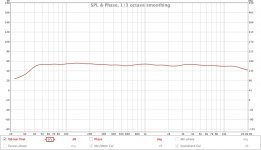Video: That’s exactly what I was going to try - a HDD pivot voice coil motor and a square or triangular column. It sounds like a tweeter. Not much bass and not surprising as bass requires displacement of real large volumes of air. I think this may be good for a high crossover FAST at maybe 800Hz is my guess. But then the best speaker there is the Hill Plasmatronics plasma ball speaker. I have heard reports that it sounds like reality squeezed down to a little bubble 3D point source.
hillplasmatronics.com
hillplasmatronics.com
This invention has popped up a couple times in the last few years. I have always been intrigued by it. My hat's off to you, planot! A full range line source is an intriguing concept.
Like the others who have never seen or heard a live one in the wild, I have some doubts:
I have trouble accepting that the motor can control the angular acceleration of such a large mass accurately enough to play complex high frequency harmonics, like close miked solo violin, or harmon muted trumpet playing high notes very loudly to surpass the musical satisfaction of a good tweeter of current common technology. A powerful motor brings more control, at the price of higher moving mass, so methinks you eventually end up with a "Saturn 5" to do the job a "Vespa" silk dome could do.
Also, I am concerned that low frequency high SPL square wave signals (like planet destroying weapons in alien invasion movies) should twist the long, thin diaphragm into spaghetti. Or at least make audio phase distortion as the top end of the diaphragm rotates out of phase with the bottom due to torsional flexibility. But I can imagine how to build a diaphragm stiff enough to avoid that at low frequencies. But not light enough to be run at high frequencies. I suppose it's possible with high torque motor with low moving mass.
Really, the diaphragm rigidity and rotational mass of the system are my biggest sticking points. But I love the electro-mechanical concept. Very fun brain puzzle.
I first thought the "fanning" effect, an impulse caused by the tips moving through air would be the cause of the sound, but the effective area of the "fans" is very small, doubt it could play low frequency. Then I thought that the small fans must create turbulence, like oars in the water, little tornados near the flats between the tips, and the energy in these tornados must be dissipated with each reversal of the diaphragm. This collapsing of stored rotational energy could make the compression while the creation of the new tornado causes the rarification. But you can't create and destroy the same tornado at the same time, and the fans are both pushing and pulling simultaneously, so there would be 6 tornadoes, 2 per triangle tip spinning opposite direction. Each swipe of the fan creates a new tornado while simultaneously destroying the other. Analysis of a rotationally oscillating triangle might prove interesting, adjusting the size and freq of the triangle oscillations to see what happens in 2D.
Questions for Planot:
Do you have one of these speakers running for your own listening pleasure?
Is your published frequency response from a real speaker or theoretical/simulation?
Thanks for your participation in this discussion, planot. I hope some meaningful insights are unearthed, as I would like to understand how it works better, along with the strengths and weaknesses of the concept. I look forward to studying your website too.
Like the others who have never seen or heard a live one in the wild, I have some doubts:
I have trouble accepting that the motor can control the angular acceleration of such a large mass accurately enough to play complex high frequency harmonics, like close miked solo violin, or harmon muted trumpet playing high notes very loudly to surpass the musical satisfaction of a good tweeter of current common technology. A powerful motor brings more control, at the price of higher moving mass, so methinks you eventually end up with a "Saturn 5" to do the job a "Vespa" silk dome could do.
Also, I am concerned that low frequency high SPL square wave signals (like planet destroying weapons in alien invasion movies) should twist the long, thin diaphragm into spaghetti. Or at least make audio phase distortion as the top end of the diaphragm rotates out of phase with the bottom due to torsional flexibility. But I can imagine how to build a diaphragm stiff enough to avoid that at low frequencies. But not light enough to be run at high frequencies. I suppose it's possible with high torque motor with low moving mass.
Really, the diaphragm rigidity and rotational mass of the system are my biggest sticking points. But I love the electro-mechanical concept. Very fun brain puzzle.
I first thought the "fanning" effect, an impulse caused by the tips moving through air would be the cause of the sound, but the effective area of the "fans" is very small, doubt it could play low frequency. Then I thought that the small fans must create turbulence, like oars in the water, little tornados near the flats between the tips, and the energy in these tornados must be dissipated with each reversal of the diaphragm. This collapsing of stored rotational energy could make the compression while the creation of the new tornado causes the rarification. But you can't create and destroy the same tornado at the same time, and the fans are both pushing and pulling simultaneously, so there would be 6 tornadoes, 2 per triangle tip spinning opposite direction. Each swipe of the fan creates a new tornado while simultaneously destroying the other. Analysis of a rotationally oscillating triangle might prove interesting, adjusting the size and freq of the triangle oscillations to see what happens in 2D.
Questions for Planot:
Do you have one of these speakers running for your own listening pleasure?
Is your published frequency response from a real speaker or theoretical/simulation?
Thanks for your participation in this discussion, planot. I hope some meaningful insights are unearthed, as I would like to understand how it works better, along with the strengths and weaknesses of the concept. I look forward to studying your website too.
Modern computer fluid dynamics (CFD) code written by researchers in the field routinely solve these types of problems. Packaged codes like Fluent may not be able to handle a time dependent viscous drag problem with oscillatory boundary conditions. But I know of custom codes that do this all the time. The problem is the vortex shedding at the tips, this will add distortion at high power levels as you create turbulent “roar” of a propeller. Adding a motor at top and bottom driven in phase will help increase the response a lot. Use of a stiff but light carbon fiber rotor is going to be essential. I think if the rotor is triangular, the polar will be symmetric about 120deg not uniform 360 like the round MBL.
An externally hosted image should be here but it was not working when we last tested it.
I gotta say, 12 vertical grids at 20dB per doesn't exactly inspire confidence in the measurements
This thread totally needs more visualization:
From the website:
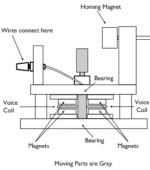
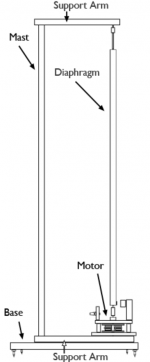
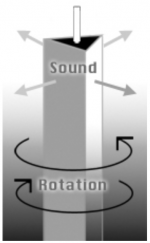
And from the patent:
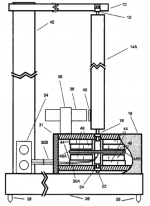
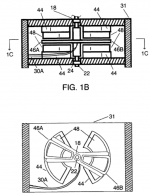
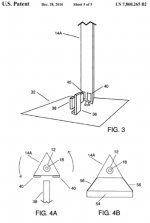
"ABSTRACT
The design of a diaphragm for a rotary loudspeaker driver that eliminates phase cancellation and therefore eliminates the necessity of a box to acoustically isolate the front Sound from the back.
The key element of the design of the diaphragm is to use a cross section of at least three equal sides. This allows for the long sides of the diaphragm to create essentially positive pressure only as it rotates and creates a very rigid structure.
Further by sizing the cross section to the width of the highest frequency to be produced you allow for a nearly perfect 360 degree radiation at all frequencies.
...
In the planar magnetic design it is the edge of the diaphragm that is fixed to the frame. Therefore the diaphragm serves the double and contradictory function of being the rigid diaphragm and the Surround that is flexible.
The planar magnetic diaphragm moves more like a drum head than a piston. This nonlinear movement is minimized only by its large Surface. It is the very nature of the surrounds elasticity that invites nonlinear movement when the diaphragm is moving. The thin and flexible diaphragms of loudspeakers flex while operating.
When combined, the materials used for the surrounds and spiders and diaphragms these materials’ nonlinearities are compounded. The whole system is often operating outside of the narrow linear envelope of accurate reproduction.
These distortions are sometimes considered euphonic or non-irritating but are definitely distortions. The surround and the spider are flexible and are asked to perform the contradictory functions of providing spring and stiffness.
The flexing of traditional pistonic diaphragms is a result of designing for the thinnest and lightest materials to construct diaphragms.
Thicker and therefore more rigid diaphragms are inherently more linear but put too large a mass burden on the surrounds of rubber and foam of the conventional cone and dome pistonic drivers.
...
ADVANTAGES
My driver eliminates the need for the loudspeaker box to isolate the negative backwave from meeting the positive front wave in phase and canceling out the Sound wave. This also eliminates reflections of sound off of the loudspeaker box Surrounding the driver—a major consideration.
My driver design allows for a full-range range driver which is able to produce the lowest audible frequencies to the highest audible frequencies with a single driver.
My driver will radiate sound at all frequencies from the low to the high frequencies in a cylindrical wave of 360 degrees in the horizontal plane and in a vertical plane equivalent to the height of the driver.
My driver eliminates the necessity for an elastic material to center the diaphragm in its home position. My driver allows for the use of a magnetic repulsion system for holding the diaphragm and the Voice coil assembly in its home position while allowing the diaphragm to rotate in response to the electrical signal applied to the Voice coil.
US 7,860,265 B23
My driver eliminates the flexing of a traditional cone or dome driver due to my driver's diaphragm’s geometry. My driver uses bearings to fix the movement of the diaphragm and the Voice coil in a perfect plane of movement as seen in FIG. 1A.
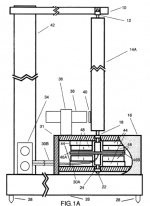
"
From the website:



And from the patent:



"ABSTRACT
The design of a diaphragm for a rotary loudspeaker driver that eliminates phase cancellation and therefore eliminates the necessity of a box to acoustically isolate the front Sound from the back.
The key element of the design of the diaphragm is to use a cross section of at least three equal sides. This allows for the long sides of the diaphragm to create essentially positive pressure only as it rotates and creates a very rigid structure.
Further by sizing the cross section to the width of the highest frequency to be produced you allow for a nearly perfect 360 degree radiation at all frequencies.
...
In the planar magnetic design it is the edge of the diaphragm that is fixed to the frame. Therefore the diaphragm serves the double and contradictory function of being the rigid diaphragm and the Surround that is flexible.
The planar magnetic diaphragm moves more like a drum head than a piston. This nonlinear movement is minimized only by its large Surface. It is the very nature of the surrounds elasticity that invites nonlinear movement when the diaphragm is moving. The thin and flexible diaphragms of loudspeakers flex while operating.
When combined, the materials used for the surrounds and spiders and diaphragms these materials’ nonlinearities are compounded. The whole system is often operating outside of the narrow linear envelope of accurate reproduction.
These distortions are sometimes considered euphonic or non-irritating but are definitely distortions. The surround and the spider are flexible and are asked to perform the contradictory functions of providing spring and stiffness.
The flexing of traditional pistonic diaphragms is a result of designing for the thinnest and lightest materials to construct diaphragms.
Thicker and therefore more rigid diaphragms are inherently more linear but put too large a mass burden on the surrounds of rubber and foam of the conventional cone and dome pistonic drivers.
...
ADVANTAGES
My driver eliminates the need for the loudspeaker box to isolate the negative backwave from meeting the positive front wave in phase and canceling out the Sound wave. This also eliminates reflections of sound off of the loudspeaker box Surrounding the driver—a major consideration.
My driver design allows for a full-range range driver which is able to produce the lowest audible frequencies to the highest audible frequencies with a single driver.
My driver will radiate sound at all frequencies from the low to the high frequencies in a cylindrical wave of 360 degrees in the horizontal plane and in a vertical plane equivalent to the height of the driver.
My driver eliminates the necessity for an elastic material to center the diaphragm in its home position. My driver allows for the use of a magnetic repulsion system for holding the diaphragm and the Voice coil assembly in its home position while allowing the diaphragm to rotate in response to the electrical signal applied to the Voice coil.
US 7,860,265 B23
My driver eliminates the flexing of a traditional cone or dome driver due to my driver's diaphragm’s geometry. My driver uses bearings to fix the movement of the diaphragm and the Voice coil in a perfect plane of movement as seen in FIG. 1A.

"
Last edited:
Video: It sounds like a tweeter. Not much bass and not surprising as bass requires displacement of real large volumes of air...
This prototype was missing a critical components, the homing magnets (HM). The HM’s are critical for a smooth and extended response. See the frequency responce plot on my Web site.
From my Web site ...
“A large homing magnet is held in place by a bracket and is attached to the motor frame. A small homing magnet is placed on the side(s) of the diaphragm (or rotor) and whose pole faces the same pole of the large homing magnet. This Magnetic structure keeps the diaphragm & voice coil assemble centered in the magnets and provides dampening to the moving parts.”
John
Last edited:
Questions for Planot:
Do you have one of these speakers running for your own listening pleasure?
Then, I guess not, then.
See the frequency responce plot on my Web site.
The one Bill posted on reply #25?
Indeed, 20dB scale, 1/3 smoothing... not much to look at.
With these parameters, my speakers look as good as yours!
Here's mine, looking good too!
Attachments
Richidoo
“Questions for Planot:
Do you have one of these speakers running for your own listening pleasure?”
Yes
“Is your published frequency response from a real speaker or theoretical/simulation?”
A real measurement.
“Thanks for your participation in this discussion, planot. I hope some meaningful insights are unearthed, as I would like to understand how it works better, along with the strengths and weaknesses of the concept. I look forward to studying your website too.”
Thank you.
John
“Questions for Planot:
Do you have one of these speakers running for your own listening pleasure?”
Yes
“Is your published frequency response from a real speaker or theoretical/simulation?”
A real measurement.
“Thanks for your participation in this discussion, planot. I hope some meaningful insights are unearthed, as I would like to understand how it works better, along with the strengths and weaknesses of the concept. I look forward to studying your website too.”
Thank you.
John
Member
Joined 2009
Paid Member
From this thread I've picked out that it's $1000 just for permission. That the designer has one, but is keeping it to himself and offering links to someone elses build that sounds terrible. That it's actually not his brainchild, but one that's been around for years and never taken off. And this patent owner doesn't want to run with it at all. Not even wanting a share if you get a reduced price license and run it through kickstarter.
I can only draw the conclusion that it doesn't work. Pages on, it's the general consensus. If it does, then why can't we see this device I'm told exists?
You know that feeling of annoyance you get when someone thinks they can rip you off? I have it.
I can only draw the conclusion that it doesn't work. Pages on, it's the general consensus. If it does, then why can't we see this device I'm told exists?
You know that feeling of annoyance you get when someone thinks they can rip you off? I have it.
“Is your published frequency response from a real speaker or theoretical/simulation?”
A real measurement.
Can you tell us what the SPL in dB is for 1W rms of input electrical power at 1m?
We need to use accepted standards in order to compare to existing SOA if one wants to say it is better.
The patent has to be written with enough detail so that anyone versed in the art can reproduce the findings presented. There should not be a need for anyone to pay $1000 to try this out as a DIY experiment for personal use. I have not read the patent carefully, but it probably has enough info, unless the patent examiner was not careful and let it get granted without being descriptive enough.
If you look at some really groundbreaking audio patents like Danley's Synergy horn - he gives enough info that there are at least 500 threads with people successfully building them, and they sound great, AND Danley offers tips and help to those who are trying them out as DIY projects. (at least he used to).
@Planot: we are not telling you how to run your business only that we are showing interest, and you really could help your case by helping get the word out through DIY efforts for people to hear about it. But if you don't want to, that's ok. I don't think there are trolls here. I think I hear exasperated and frustrated people who want to know and experience this transformational sound technology but are met with a game of hiding the ball.
A courtesy...
I respond to questions here, to preexisting threads, as a courtesy and in the interest of furthering the art.
I have developed prototypes at great personal expense and over many years and I have no intention of giving that away.
I do not need to justify myself.
My prototype was developed as an experimental platform for licensed developers.
There was never a thought at conception or later, to market it to DIY’s/hobbyists except that they inquired.
It is priced to companies. It was only as a courtesy to inquiries that I had made it available to hobbyists.
———
I am not accusing everyone at DIYAUDIO that does not agree with me of being a troll.
Unfortunately these rational discussions are often cut short by trolls.
The goal of a troll is to shut down a discussion. “Nothing here to see folks because I say so.” They’re bullies of the worst kind. Loveless, hatefilled, individuals, who want no one else to voice an opinion unless these self appointed arbiters of truth have anointed them.
I have had private dialogues with quite a few people here and we know who the trolls are.
“Merriam-Webster
a : to antagonize (others) online by deliberately posting inflammatory, irrelevant, or offensive comments or other disruptive content
… trolls engage in the most outrageous and offensive behaviors possible—all the better to troll you with. —Whitney Phillips”
I welcome questions about the technology and applications as long as the discussion proceeds in an adult and non-threatening manner.
Please feel free to e-mail your questions and comments to info@planotspeaker.com
John
I respond to questions here, to preexisting threads, as a courtesy and in the interest of furthering the art.
I have developed prototypes at great personal expense and over many years and I have no intention of giving that away.
I do not need to justify myself.
My prototype was developed as an experimental platform for licensed developers.
There was never a thought at conception or later, to market it to DIY’s/hobbyists except that they inquired.
It is priced to companies. It was only as a courtesy to inquiries that I had made it available to hobbyists.
———
I am not accusing everyone at DIYAUDIO that does not agree with me of being a troll.
Unfortunately these rational discussions are often cut short by trolls.
The goal of a troll is to shut down a discussion. “Nothing here to see folks because I say so.” They’re bullies of the worst kind. Loveless, hatefilled, individuals, who want no one else to voice an opinion unless these self appointed arbiters of truth have anointed them.
I have had private dialogues with quite a few people here and we know who the trolls are.
“Merriam-Webster
a : to antagonize (others) online by deliberately posting inflammatory, irrelevant, or offensive comments or other disruptive content
… trolls engage in the most outrageous and offensive behaviors possible—all the better to troll you with. —Whitney Phillips”
I welcome questions about the technology and applications as long as the discussion proceeds in an adult and non-threatening manner.
Please feel free to e-mail your questions and comments to info@planotspeaker.com
John
I do not need to justify myself.
You kinda do when you are asking people to give you $1,000 just for the plans of a prototype that will cost $5,000 to build... people will need something to trust you, besides the sayings of: "I built one and it should work as expected."
I have developed prototypes at great personal expense and over many years and I have no intention of giving that away.
My prototype was developed as an experimental platform for licensed developers.
So, the whole thing is still in prototype form, and no real world application has been developed. It is still an experiment, that "licensed" users will have to develop further and take it to the next level, as it is not ready for any kind of real use yet.
It is priced to companies.
How many big companies out there are running with this? I haven't seen one yet.
The people here are (usually) not trolls... they just are interested in anything new under the sun that concerns their audio hobby. Getting people excited about something is a good start to get a product some exposure. But you seem to shut the door at every opportunity.
Many of us have asked some kind of proof that it works as advertised, but the only answer we get is a quote from a dictionary. Hardly audio related.
I've shown a graphic that I can get pretty much the same result as your contraption, and you are unwilling to tell us how your design work any better.
Alright, John, have it your way.
I, like many others, was very curious about this, and would have loved to help get the ball rolling, but the huge capitalist smoke and mirrors wall you put in front of it gives it a sour taste.
Good luck with the company deals.
I'd like to see a real video, I don't mind if it's not of the best quality available yet, but something to prove this is indeed a wide band design would be great to see.
You have measurements, lets see the IR and STEP. That will show if the wording in the patent has any meaning.
Let's see the FR at something else than this obscure scale and without 1/3 octave smoothing.
Even a harddrive has more bass that the only example shown:
YouTube
You have measurements, lets see the IR and STEP. That will show if the wording in the patent has any meaning.
Let's see the FR at something else than this obscure scale and without 1/3 octave smoothing.
Even a harddrive has more bass that the only example shown:
YouTube
That doesn't appear to have changed. I wonder why he chose to resurrect this thread now.Reading the responses in the old posts, it seems that interest died due to the inventors crazed defenseive stance on profiting from the design by licensing to large corporations.
I remain intrigued by the concept even if I think Planot is a bit possessive of his very premature 'baby'. Much more development work is needed.
So my own mind games and intuition suggest a multi-sided pyramidal vane that is able to twist but is driven by multiple oscillating motors for low, mid, high for example. The wider low end of the pyramid with stronger motors and greater air movement etc. The flexibility intended to allow a continuum linking the motors and to allow phase differences between motors (as in real music).
Like a wing on a cross bar kite perhaps? And perhaps the motors are simply adapted voice coils and pistons?
Has the potential to keep me experimenting for years.
So my own mind games and intuition suggest a multi-sided pyramidal vane that is able to twist but is driven by multiple oscillating motors for low, mid, high for example. The wider low end of the pyramid with stronger motors and greater air movement etc. The flexibility intended to allow a continuum linking the motors and to allow phase differences between motors (as in real music).
Like a wing on a cross bar kite perhaps? And perhaps the motors are simply adapted voice coils and pistons?
Has the potential to keep me experimenting for years.
I was thinking of a multiway with 3 or 4 different diameter rotors/folded diaphragms/vanes each with their own motor. I looked at the patent carefully and it appears this is the very first patent that I have seen with only one claim. That leaves to door open to a lot of variations that are not claimed, hence unprotected to other variations that are not obvious to those skilled in the art.
- Status
- Not open for further replies.
- Home
- Loudspeakers
- Full Range
- First Constant Directicty Fullrange Omni Enclosureless Speaker!
